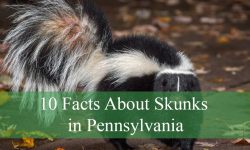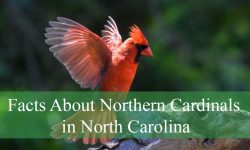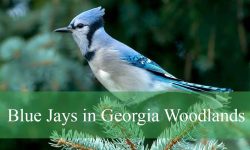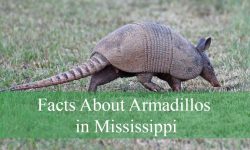New York may be best known for its skyscrapers and busy streets, but the state is also home to a surprising variety of insects that can cause real problems for residents and outdoor explorers. From quiet forests and suburban yards to city parks and lakesides, many bugs thrive in the region’s diverse habitats, and some of them are far more dangerous than most people expect. As outdoor activity increases throughout the warmer months, recognizing these species becomes increasingly important.
Some insects become hazardous because of their venomous stings or painful bites, while others spread illnesses that can lead to serious medical complications. A few are more of a nuisance than a direct threat, yet they can still spark allergic reactions, infections, or unpleasant encounters that leave lasting discomfort. Their appearances and behaviors vary widely, making identification an essential part of avoiding risks.
This guide brings together the 24 most dangerous bugs in New York and offers clear identification tips, behavior insights, and explanations of the dangers each species presents. The goal is to help readers understand what to watch for, how these insects fit into local environments, and what steps can reduce the likelihood of harmful encounters while enjoying the outdoors.
Types of Dangerous Bugs Found in New York
Black-Legged Tick (Deer Tick)
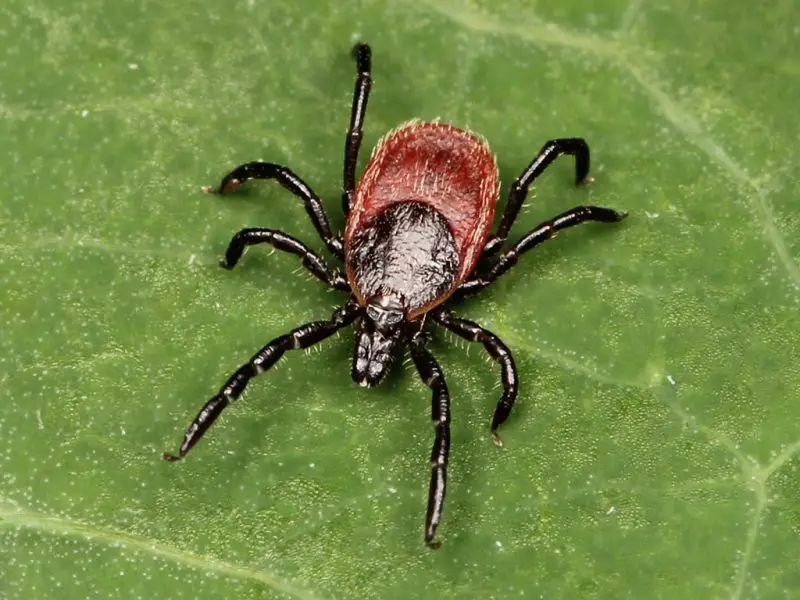
The black-legged tick is one of New York’s most medically significant arachnids, known for its small size and reddish-brown body. Adults have a flat, oval shape with dark legs that contrast against the lighter abdomen, making them distinct from other tick species found in the region. Their tiny nymphs are even harder to identify, often no bigger than a poppy seed, which increases the risk of unnoticed bites.
This species typically measures about 2 to 3 millimeters as a nymph and up to 5 millimeters as an unfed adult. After feeding, they swell significantly, taking on a grayish, engorged appearance. Their small size allows them to attach easily to skin or clothing, especially during spring and early summer when nymphs are most active.
Black-legged ticks thrive in wooded areas, shaded leaf litter, tall grasses, and moist environments across New York. They are commonly encountered in forests, suburban trails, and properties bordering dense vegetation. Their behavior depends on “questing,” a process where they climb vegetation and wait for passing hosts such as deer, mice, and humans.
This species carries pathogens responsible for Lyme disease, babesiosis, and anaplasmosis, all of which pose serious risks to people. Their bite is painless, allowing infections to spread before detection. While not all ticks carry pathogens, the black-legged tick is considered the most dangerous tick in New York due to its infection rate and widespread presence.
Brown Dog Tick
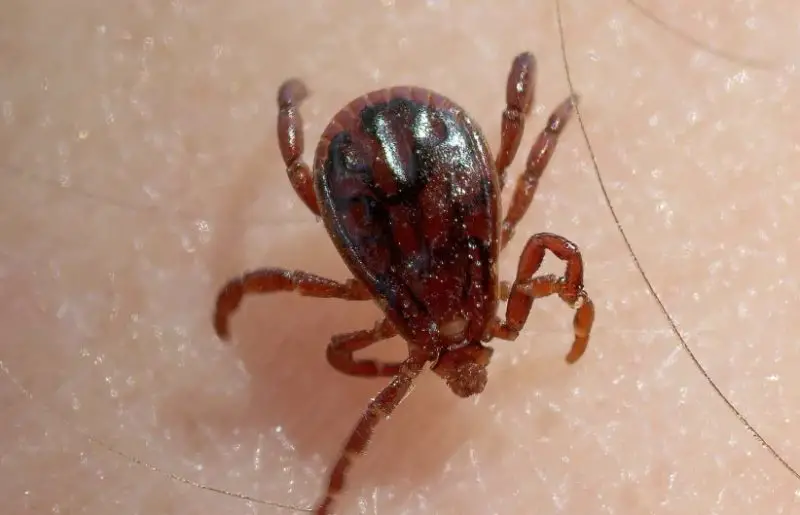
The brown dog tick is a widely distributed species that is increasingly encountered in homes, kennels, and urban settings across New York. It has a reddish-brown body with a smooth, elongated shape that makes it easier to distinguish from the darker and rounder black-legged tick. Unlike many tick species, it thrives in indoor environments, enabling it to reproduce inside residential areas.
Adult brown dog ticks typically measure between 3 and 5 millimeters when unfed, enlarging significantly after a blood meal. Their slim body shape and reddish coloration remain consistent across life stages, though nymphs and larvae appear much smaller. They possess a shield-like scutum and long mouthparts designed for firmly attaching to their hosts.
This species is highly adaptable and can complete its entire life cycle indoors, which is unusual for ticks. It prefers warm, dry environments such as dog bedding, cracks in flooring, kennels, and household corners. Outdoors, it may be found in yards, near dog houses, or in areas frequented by domestic pets. Its strong association with dogs increases the risk of infestations in homes with pets.
Brown dog ticks are capable of transmitting several pathogens, including Rocky Mountain spotted fever in certain regions, though infections remain relatively rare in New York. Their bites can cause irritation, inflammation, and secondary infections if not treated properly. Because they can establish indoor populations, infestations may grow quickly, making prompt control essential for preventing widespread exposure.
Lone Star Tick
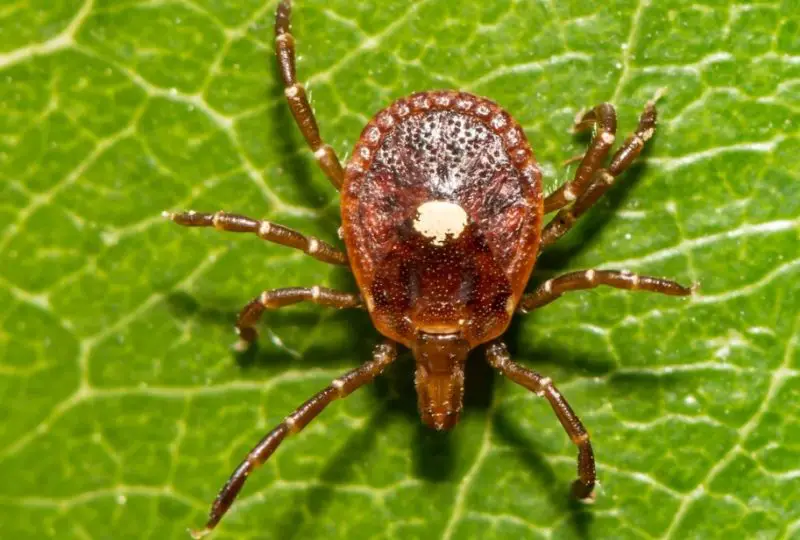
The lone star tick is recognized by the distinctive white dot on the back of adult females, which makes identification easier compared to many other ticks in New York. Their coloration ranges from reddish to dark brown, giving them a more robust appearance. This species is highly active and moves more quickly than other common ticks.
Adults reach about 5 to 7 millimeters in size, with females being larger than males. Nymphs and larvae are significantly smaller but still aggressive feeders. Their mouthparts are longer than those of deer ticks, allowing for deeper attachment and making removal more difficult once they latch onto the skin.
Lone star ticks inhabit brushy woods, overgrown fields, coastal areas, and regions with dense ground cover. They favor warm conditions and have expanded northward into New York in recent years. Unlike many ticks that rely primarily on passive waiting, lone star ticks may actively move toward a host when sensing heat and carbon dioxide.
This species is dangerous because its bites can trigger alpha-gal syndrome, a potentially life-altering allergy that causes reactions to red meat. They are also capable of transmitting ehrlichiosis and tularemia. Their bites often cause large, itchy welts, and because they attach firmly, improper removal can increase the risk of infection.
American Dog Tick
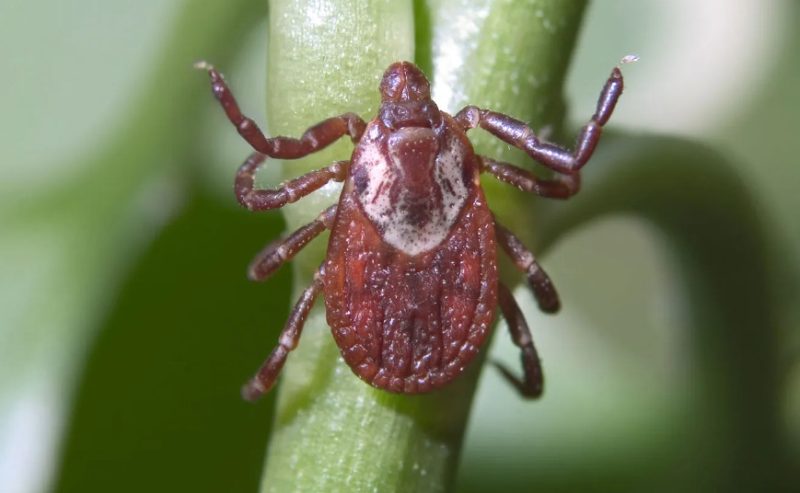
The American dog tick is one of the largest ticks found in New York and is recognized by its brown body with mottled white or gray markings on the scutum. This species is easier to spot compared to deer ticks, which often makes identification less challenging. Despite its name, it feeds on a wide variety of mammals, including humans.
Adults frequently measure between 5 and 15 millimeters, depending on whether they have fed. Their large, rounded bodies and ornate patterns make them visually distinct. Nymphs and larvae are smaller but still more visible than those of many other species, reducing the likelihood of unnoticed bites.
American dog ticks are commonly found in open fields, meadows, and grassy trails, particularly in areas where dogs and wildlife pass frequently. They prefer environments with direct sunlight more than the shaded habitats preferred by deer ticks. Their questing behavior involves climbing tall grass and extending their front legs to grab passing hosts.
This species is a known vector of Rocky Mountain spotted fever, a potentially fatal illness if untreated. Their bites can also cause tick paralysis in pets and occasionally in humans. While they are less likely to carry Lyme disease, their overall size, strong attachment, and pathogen potential make them a significant concern in New York.
Red Imported Fire Ant
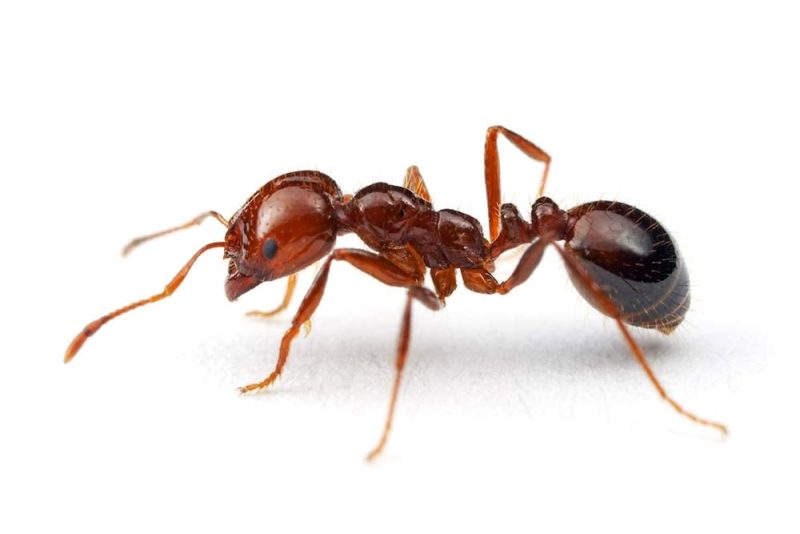
The red imported fire ant is a highly aggressive species occasionally reported in localized areas of New York due to transported soil or warmer microclimates. These ants are reddish-brown with darker abdomens and typically form large colonies that expand rapidly. Their coordinated behavior and defensive nature distinguish them from native ant species.
Workers generally measure between 2 and 6 millimeters, with the colony containing multiple size classes. Their mandibles deliver a sharp pinch, but the true danger comes from their stinger, which injects venom containing toxic alkaloids. When disturbed, they swarm aggressively, stinging repeatedly and simultaneously.
Fire ants prefer warm, sunny environments such as lawns, parks, agricultural fields, and disturbed soil. Although New York’s climate is not ideal for year-round populations, temporary colonies can survive in mulch shipments, construction materials, and heated urban pockets. Their mounds are distinctive, appearing as loose soil piles without a central opening.
The sting of a red imported fire ant causes intense burning pain followed by pustule formation. For sensitive individuals, a swarm attack can trigger anaphylaxis, making this species extremely dangerous. Even a single sting can cause long-lasting irritation or infection. Because they behave in coordinated groups, encounters often result in multiple stings rather than just one.
Yellowjacket Wasp
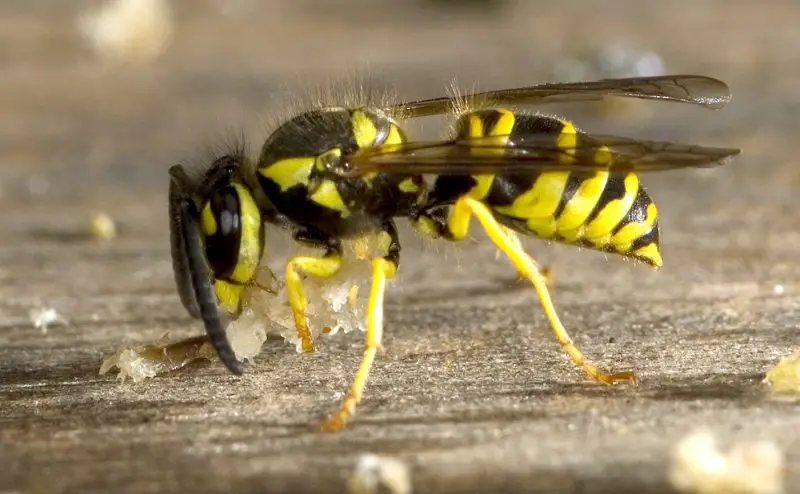
Yellowjacket wasps are among the most aggressive stinging insects in New York, easily recognized by their bright black-and-yellow bands and slender, wasp-like bodies. They have smooth, shiny exteriors and a narrow waist that sets them apart from bees. Their quick flight patterns and hovering behavior often make them noticeable around food sources and outdoor gatherings.
These wasps typically measure between 10 and 16 millimeters in length, depending on the species and season. Workers are smaller, while queens can be considerably larger. Their stingers are smooth, allowing them to sting multiple times without dying, which increases the risk during encounters.
Yellowjackets build nests in hidden or enclosed spaces such as underground burrows, wall voids, tree cavities, and sheds. Throughout late summer, populations peak, and their behavior becomes more defensive and food-focused. They are highly protective of their colonies and will swarm rapidly if disturbed, responding collectively to threats.
The stings of yellowjackets are extremely painful and can inject a potent venom that causes swelling, burning, and redness. For individuals with venom allergies, a single sting can lead to anaphylaxis, and multiple stings from a swarm can be dangerous even to non-allergic individuals. Their tendency to attack in groups makes them one of the more hazardous insects in New York.
Bald-Faced Hornet
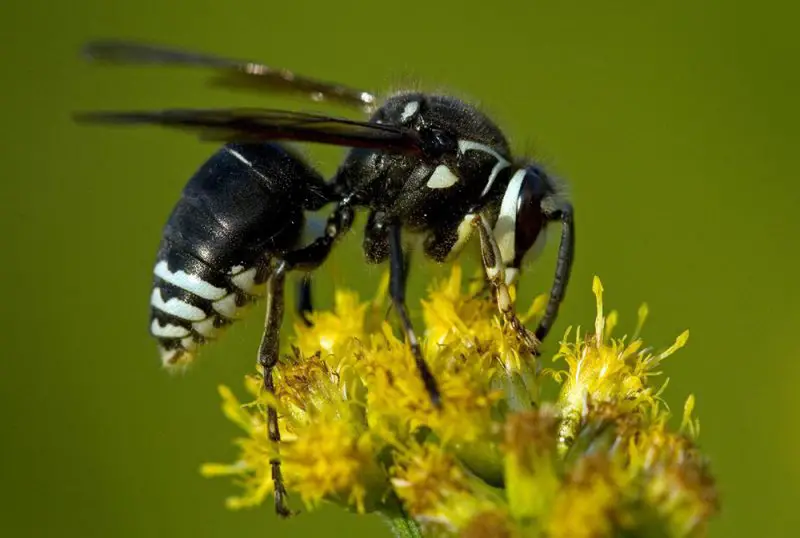
Bald-faced hornets stand out due to their striking black bodies contrasted with white or pale markings on the face, thorax, and abdomen. Despite their name, they are technically large yellowjackets rather than true hornets. Their robust build and loud, intimidating flight make them easy to recognize at close range.
Adults range from 12 to 20 millimeters in length, making them larger than most wasps encountered in New York. Their size, combined with their distinctive coloration, gives them a powerful presence. They also possess a smooth stinger capable of repeated use, which increases the severity of defensive attacks.
These hornets build large, enclosed paper nests high in trees, on building eaves, or in dense shrubs. Their nests can reach the size of a basketball by late summer. Bald-faced hornets are highly territorial and respond aggressively to any disturbance near their nest. Their defensive behaviors include rapid swarming and persistent pursuit of perceived threats.
The venom of bald-faced hornets is particularly potent, causing intense pain, significant swelling, and sometimes prolonged skin irritation. Because they can sting repeatedly and attack in numbers, encounters near their nests can become dangerous quickly. Their combination of size, aggression, and venom potency makes them one of the most feared stinging insects in New York.
European Hornet

European hornets are the only true hornet species established in New York and are noticeably larger than most native wasps. They have reddish-brown heads and thoraxes with yellow abdominal bands, giving them a bold and intimidating appearance. Their size and loud flight buzz often cause alarm when they are active around homes.
Adults typically measure between 25 and 35 millimeters, making them significantly larger than bald-faced hornets and yellowjackets. Their strong mandibles allow them to chew wood fibers, which they use to build their paper-like nests in hollow trees, attics, barns, and wall voids. Their large size helps them deliver deeper and more painful stings.
European hornets tend to be more active at night than other wasp species, often being attracted to lights near porches or windows. They hunt other insects and are capable of defending their nests aggressively when disturbed. Although generally less erratic than yellowjackets, they can attack collectively when their colony is threatened.
The sting of a European hornet is extremely painful and delivers a substantial amount of venom. Their venom can cause sharp burning sensations, swelling, and in some cases, allergic reactions. Because they defend nests vigorously and are capable of stinging multiple times, they pose a real risk to individuals who accidentally approach or disturb their colonies.
Paper Wasp
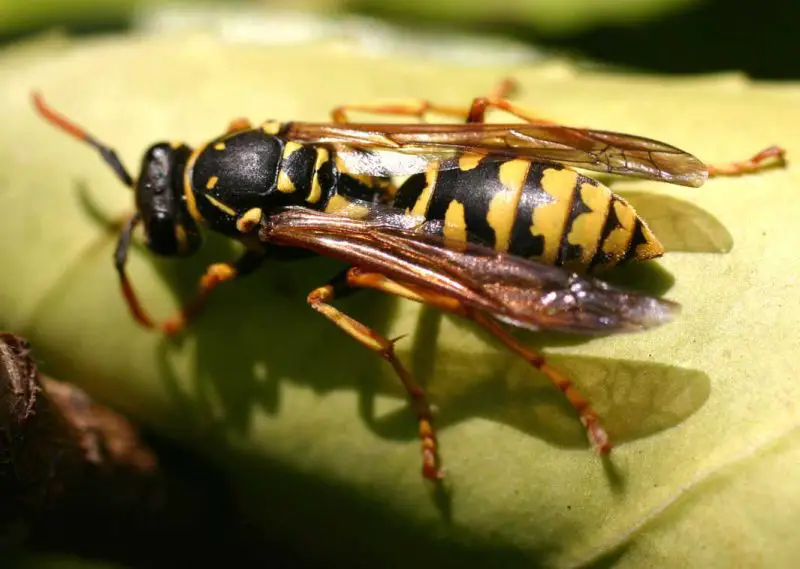
Paper wasps are slender, elegant wasps with long legs and narrow waists, commonly seen around New York homes and gardens. Their coloration varies by species but usually includes reddish, brown, or yellow patterns. Their delicate but alert posture gives them a distinctive appearance when resting on surfaces or hovering near eaves.
These wasps measure between 15 and 20 millimeters and have noticeably longer legs than many other stinging insects. Their wings fold neatly along their bodies when at rest. Unlike hornets, paper wasps build open, umbrella-shaped nests with visible hexagonal cells, typically found under roof edges, porch rails, or inside sheds.
Paper wasps prefer warm, sheltered outdoor spaces and are most active during spring and summer. They are less aggressive than yellowjackets or hornets but will defend their nests strongly when threatened. Their behavior is generally calm unless provoked, yet their proximity to human structures increases the chances of accidental encounters.
The sting of a paper wasp is sharp and painful, injecting venom that causes immediate burning and swelling. For individuals with allergies, reactions can escalate to breathing difficulties and systemic symptoms. Although they usually sting only when necessary, their nests around homes pose dangers, especially during yard work or accidental disturbances.
Mosquito (Culex & Aedes Species)
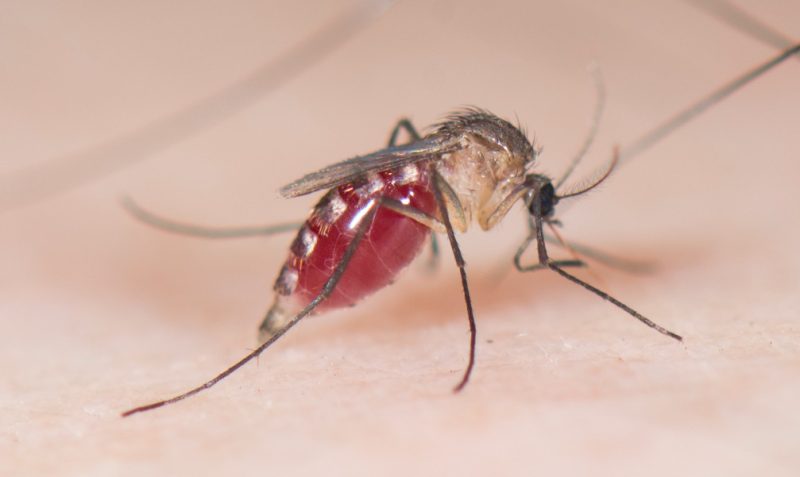
Mosquitoes from the Culex and Aedes genera are small, delicate insects with slender bodies, long legs, and narrow wings. They are usually brown to gray, though Aedes species may display black-and-white banding on their legs and bodies, making them more visually distinctive. Their light, hovering flight and soft buzzing are often the first signs of their presence.
Most mosquitoes measure around 3 to 7 millimeters in length depending on species and environmental conditions. Females possess elongated mouthparts designed for piercing skin and drawing blood, while males feed only on plant nectar. These insects are lightweight and fragile, yet remarkably efficient at locating hosts using heat and carbon dioxide cues.
Culex mosquitoes prefer stagnant water sources such as storm drains, birdbaths, ponds, and puddles, making them common in both urban and suburban areas of New York. Aedes mosquitoes often breed in containers, gutters, and tires, thriving in densely populated neighborhoods. Both groups are active during warm months, with Aedes species biting during the day and Culex species being more active at dusk and night.
Mosquitoes pose significant health risks because they can transmit pathogens, including West Nile virus, which circulates annually in New York. Aedes species can also carry viruses like dengue, Zika, and chikungunya, though these are less common in the region. Their bites can cause itching, swelling, and in some cases allergic reactions, making them one of the most medically important insects in the state.
Asian Tiger Mosquito
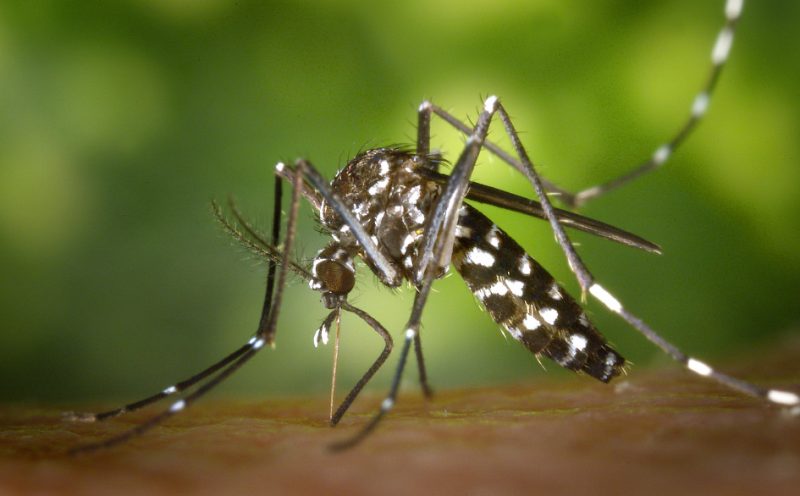
The Asian tiger mosquito is easily recognized by its striking black body marked with bold white stripes along the legs and a single white line running down the center of its back. This species has a sleek, compact appearance and moves quickly with a distinctive, darting flight pattern. Its contrasting coloration makes it one of the most identifiable mosquitoes found in New York during warm months.
Adult Asian tiger mosquitoes typically measure between 2 and 10 millimeters in length, with females being larger than males. Their long proboscis is adapted for piercing skin, and their wings are narrow and dark. Despite their small size, they are persistent biters, often following movement and targeting exposed skin repeatedly.
They thrive in urban and suburban environments, preferring small, artificial water containers such as buckets, planters, clogged gutters, and discarded tires. Asian tiger mosquitoes are active primarily during the day, particularly in shaded outdoor areas. Their ability to breed in minimal water makes them difficult to control once populations establish.
This species is medically significant because it can carry viruses such as Zika, dengue, and chikungunya. While widespread transmission is rare in New York, imported cases from travelers increase the potential risk. Their bites are itchy and irritating, and repeated biting behavior increases discomfort. Their capacity to spread dangerous viruses makes them one of the most concerning mosquito species in the region.
Assassin Bug (Kissing Bug Relatives)
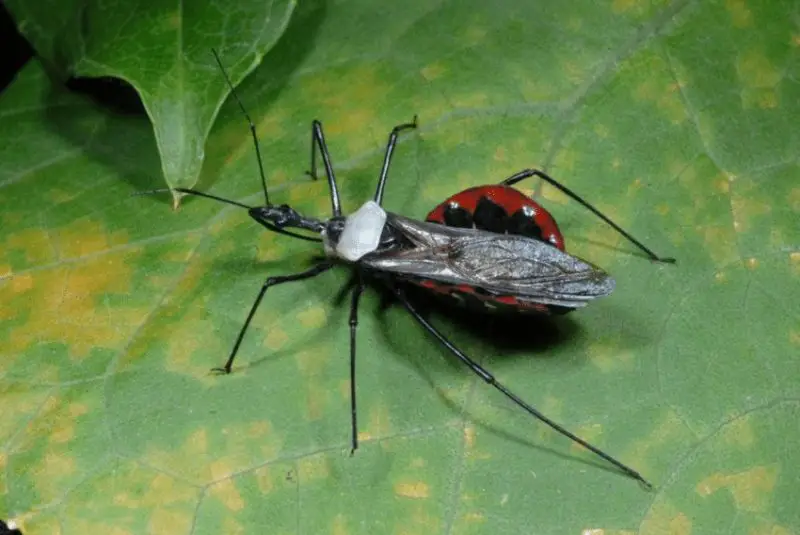
Assassin bugs commonly found in New York are close relatives of the kissing bug group, although true Chagas-carrying species are rare in the state. These insects have elongated bodies, narrow heads, and prominent, curved mouthparts designed for piercing and feeding. Their brown or dark coloration helps them blend into vegetation and leaf litter.
Adults generally measure between 12 and 25 millimeters, depending on the species. Their long legs and distinctive head shape make them easy to distinguish from beetles or other true bugs. Although most New York species feed on other insects, they can bite humans if handled or threatened.
Assassin bugs inhabit fields, gardens, forest edges, and areas with abundant insect prey. They tend to hide during the day and become more active in the evening or at night. Some species are attracted to outdoor lights, increasing the chances of accidental encounters near homes.
While true kissing bugs that transmit Chagas disease are extremely rare in New York, related species can still deliver painful bites. Their bites may cause swelling, redness, or localized allergic reactions. In rare circumstances, improper handling of imported or migrating species could expose humans to pathogens, though the threat remains low compared to southern states.
Giant Water Bug
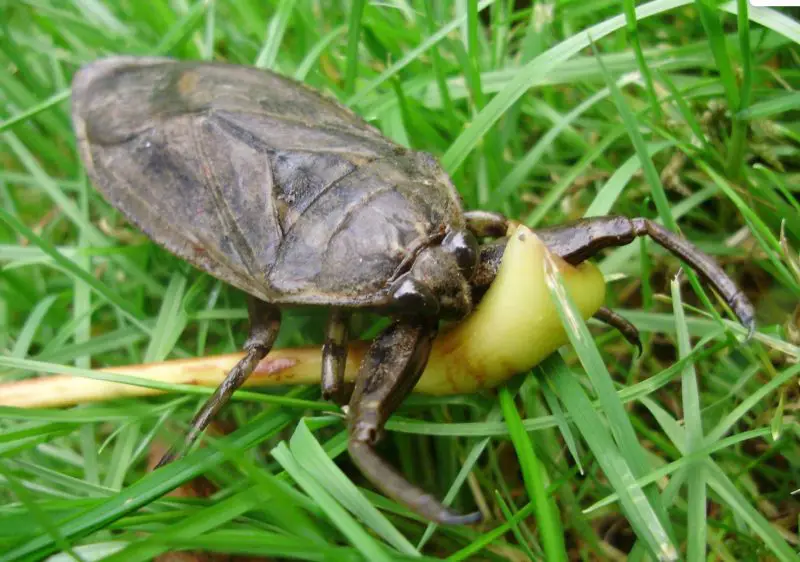
The giant water bug is one of the largest aquatic insects in New York, instantly recognizable by its flattened, oval body and tan or brown coloration. Its front legs are powerful and raptorial, adapted for grabbing prey. These insects are sometimes mistaken for cockroaches due to their size, but their broad shape and aquatic behavior distinguish them clearly.
Adults can reach impressive lengths of 30 to 65 millimeters, making them one of the largest true bugs in North America. Their strong forelegs are lined with hooks, and their piercing mouthparts are capable of delivering painful bites when handled. They have wings and can fly, often traveling toward bright lights on warm nights.
Giant water bugs live in ponds, lakes, wetlands, and slow-moving streams throughout New York. They sit motionless under the water surface, waiting to ambush fish, tadpoles, and other aquatic animals. During mating season, they may crawl or fly onto land, increasing the likelihood of human encounters around waterfront areas.
Their bite, often called a “toe-biter” attack, is extremely painful and can cause temporary numbness, swelling, or throbbing. While the venom is not medically dangerous, secondary infections can occur if wounds are not cleaned properly. Despite their formidable size and reputation, they are generally harmless unless handled carelessly.
Northern Widow Spider
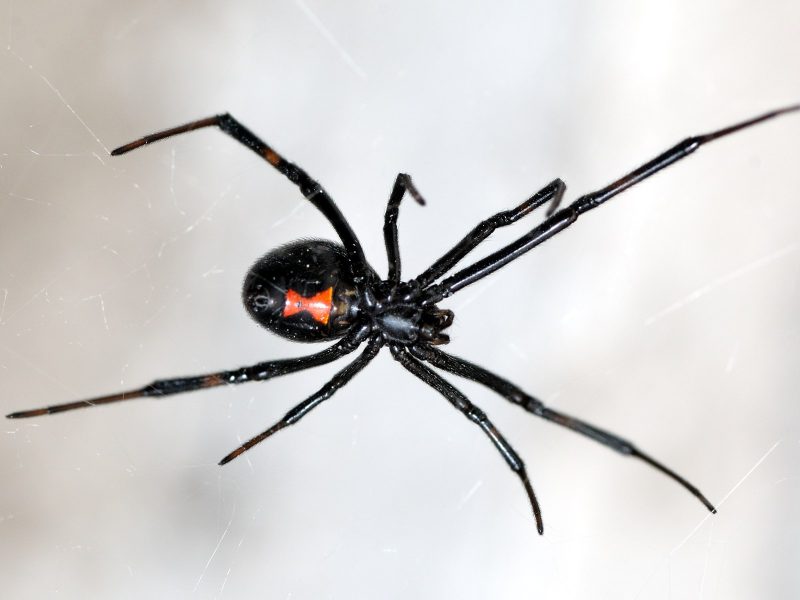
The northern widow spider is a close relative of the well-known black widow, sharing many of its traits but possessing slightly less potent venom. Females have a shiny black body with varying red or orange markings on the abdomen, though the hourglass shape may appear broken or incomplete. Males are smaller, lighter, and less dangerous.
Adult females typically measure between 8 and 13 millimeters in body length, with long slender legs that give them a larger overall appearance. Males are much smaller and rarely bite. Their webs are messy, irregular structures usually built close to the ground in hidden crevices.
Northern widow spiders prefer dark, protected environments such as woodpiles, sheds, garages, stone walls, and basement corners. They are not commonly encountered in New York but do appear occasionally, especially in warmer southern parts of the state or in sheltered rural areas. They are generally shy and bite only when pressed against skin or provoked.
Their venom contains neurotoxins that can cause muscle cramps, sweating, and localized pain, though symptoms are typically milder than those from a southern black widow. Severe reactions are rare but can occur in children, the elderly, or individuals with underlying health issues. Proper medical attention is recommended for any suspected widow bite.
Sacropha Fly (Flesh-Eating Fly)
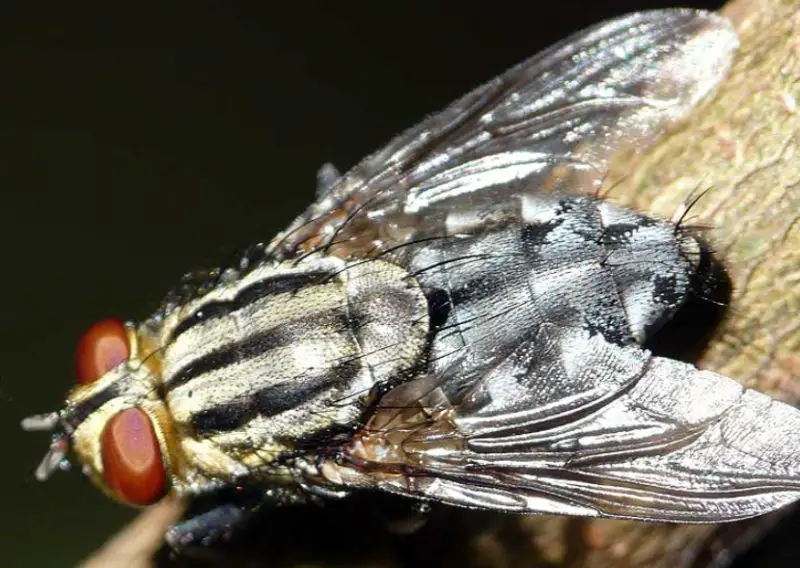
The Sarcophaga, or flesh-eating fly, is a gray, medium-sized fly with three dark stripes on its thorax and a checkered abdomen. These flies resemble common houseflies but appear slightly larger and more robust. Their red eyes and fast, darting flight make them noticeable around decaying organic matter.
Adults usually measure between 10 and 14 millimeters in length. They have bristly bodies and strong legs that help them land on uneven surfaces. Sarcophaga flies are capable of laying live larvae instead of eggs, a trait that separates them from many other fly species.
These flies thrive in environments rich in decaying materials, including garbage areas, compost piles, roadkill sites, and neglected corners of farms or parks. They are frequently found in both rural and urban settings across New York. They often enter homes in search of food scraps or animal remains.
While they do not possess venom or a stinger, their danger comes from the bacteria they carry on their bodies and in their digestive systems. They can spread harmful pathogens to surfaces, wounds, and food. In rare cases, their larvae can infest open wounds, leading to severe infections. Their role as disease vectors makes them one of the more concerning fly species in the region.
Horse Fly

Horse flies are large, fast-flying insects with broad bodies, strong wings, and strikingly colorful eyes that shimmer in shades of green, gold, or purple. Their bodies are typically gray or brown, and they resemble oversized houseflies with a more robust build. Females are the ones that bite, using their powerful mouthparts to tear the skin of mammals, including humans.
These flies usually measure between 10 and 25 millimeters in length, though some species can grow even larger. Their mouthparts are blade-like rather than needle-like, creating a painful laceration instead of a clean puncture. This cutting action allows blood to pool, which they then lap up with a sponge-like tongue.
Horse flies thrive in warm, humid environments such as wetlands, forests, meadows, and farms across New York. They are especially common near water sources where larvae develop in mud or moist soil. Adults are strongest during summer, often circling people, pets, livestock, and vehicles outdoors.
Their bites are extremely painful and can bleed due to the tearing nature of their mouthparts. Because their feeding process is messy and exposes the wound to bacteria, infections are possible if the bite is not cleaned properly. While they are not major disease vectors in New York, their aggressive daytime biting and potential for secondary infection make them a serious nuisance.
Bot Fly
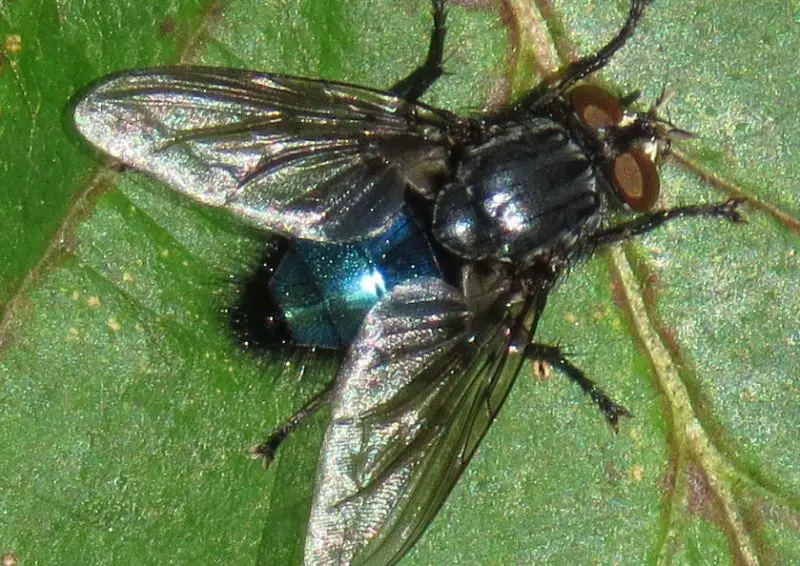
Bot flies are unique insects best known for their parasitic larvae, which can develop under the skin of mammals. Adults are stout, fuzzy flies resembling bumblebees with tan, gray, or yellow markings. Despite their intimidating reputation, adult bot flies do not bite or feed on blood; their danger comes from their reproductive behavior.
Adult bot flies typically measure between 12 and 20 millimeters in length, with rounded bodies and reduced mouthparts. They rely on speed and stealth, often depositing eggs on mosquitoes or directly on animal hair. Once hatched, the larvae burrow into skin or body openings, where they continue to develop.
In New York, bot flies are most commonly found in wooded and rural environments where wildlife hosts such as rabbits, rodents, or deer are abundant. Humans rarely become hosts, but it can happen if larvae come into contact with exposed skin or small wounds. Pets and livestock are more frequently affected.
The larval stage poses the greatest risk, creating painful, swollen boil-like lesions on the skin. Movement of the larvae inside the wound can cause significant discomfort and risk of infection. While rarely dangerous when treated promptly, the psychological impact and medical care required make bot flies one of the more unsettling insects in the region.
Blister Beetle
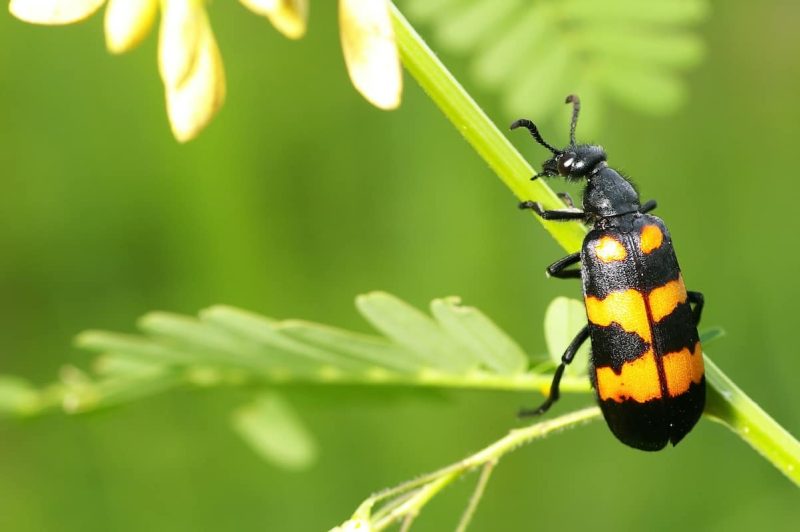
Blister beetles are slender insects with elongated bodies, soft wings, and narrow necks that give them a distinct shape compared to most beetles. Their coloration varies widely, ranging from black and brown to vibrant yellow or striped patterns. These beetles release a chemical called cantharidin, a potent blistering agent.
Adults generally measure between 12 and 25 millimeters in length, depending on the species. Their soft elytra and flexible bodies make them easy to crush, but doing so releases cantharidin, which can irritate the skin. Their heads are often noticeably wider than the thorax, making identification easier.
Blister beetles are found in meadows, gardens, agricultural fields, and forest edges throughout New York. They often feed on flowers and foliage, occasionally becoming agricultural pests. They are most active in midsummer and may appear in clusters on plants or near outdoor lights.
Contact with cantharidin causes painful skin blisters, redness, and irritation. These blisters can become large and uncomfortable, though they usually heal without long-term effects. Ingestion of cantharidin is far more dangerous, especially for pets or livestock that accidentally consume contaminated plants. Even minimal exposure can be harmful, making these beetles an insect to avoid handling.
Stink Bug (Brown Marmorated)
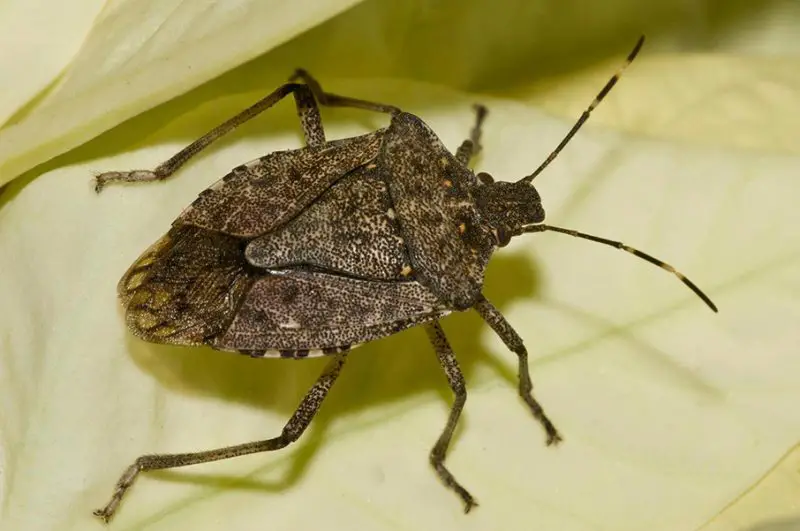
The brown marmorated stink bug is a shield-shaped insect with mottled brown coloration and alternating light-and-dark banding on its antennae and abdomen. Its distinctive triangular “shield” body makes it easy to recognize. While not dangerous in terms of venom or biting ability, it is a major nuisance pest in New York.
Adults measure about 12 to 17 millimeters in length and have broad, flattened bodies that allow them to slip into small cracks. Their legs are sturdy and slightly banded, and their wings fold neatly over the back to complete the shield shape. When threatened or crushed, they release a powerful odor.
Stink bugs thrive in gardens, orchards, and agricultural areas, feeding on fruit, vegetables, and ornamental plants. In late summer and fall, they seek warmth and shelter, often entering homes through windows, vents, and gaps in siding. Indoors, they gather in large numbers, especially in attics or wall voids.
Although they do not sting or bite, their odor can cause headaches, nausea, or respiratory irritation in sensitive individuals. Some people may experience mild skin reactions after handling them. Their main threat lies in crop damage and indoor infestations, which make them a persistent and highly annoying pest.
Carpenter Ant
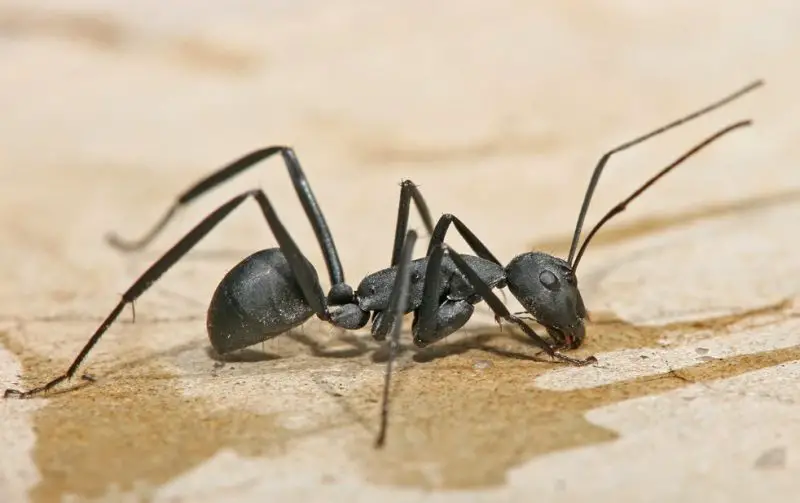
Carpenter ants are large, sturdy ants known for their ability to tunnel through wood to create nests. They are usually black or dark brown, with elbowed antennae and strong mandibles that they use for chewing. Their size and smooth, shiny appearance make them easy to differentiate from smaller household ants.
Adults range from 6 to 13 millimeters in length, with queens significantly larger. Their heads are wide, and their jaws are powerful enough to deliver a painful bite when threatened. While they do not possess stingers, their bites may be accompanied by a spray of formic acid, adding a burning sensation.
These ants prefer moist, decaying, or water-damaged wood, making them common in older homes, fallen logs, stumps, and forested areas. In New York, they often invade structures with leaks, poor ventilation, or compromised wood. Outdoor colonies can expand into houses as they search for food and suitable nesting sites.
Carpenter ants do not carry venom, but their bites can be surprisingly painful. The greater danger comes from their nesting habits, which can weaken wooden structures over time. Left untreated, a large colony can cause significant structural damage. Their combination of painful bites and destructive behavior makes them a serious pest in residential areas.
Velvet Ant (Cow Killer Ant)
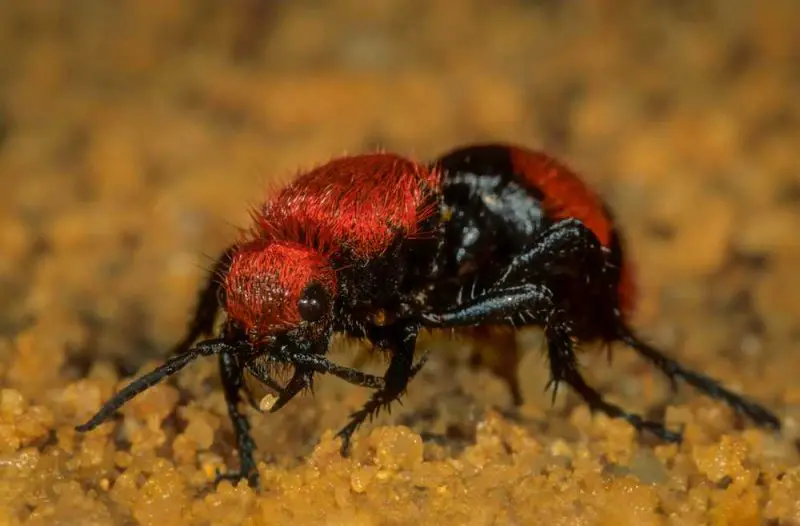
The velvet ant, despite its name, is actually a wingless female wasp known for its striking appearance and powerful sting. It has a fuzzy, velvety body covered in bright red, orange, or yellow hairs contrasted with black markings. This bold coloration serves as a warning signal, making it one of the most visually memorable insects occasionally found in New York.
Adults typically measure between 12 and 25 millimeters in length, with females being larger and more robust than males. Their bodies are tough and compact, helping them resist predators. Although wingless, females move quickly across the ground, making them harder to catch or handle safely.
Velvet ants prefer dry, sandy, or grassy habitats where they search for the nests of ground-dwelling bees and wasps. In New York, they are most likely to appear in fields, open meadows, and sunny forest edges. They are solitary and generally avoid human activity, though accidental encounters can happen when walking barefoot or handling outdoor debris.
Their sting is extremely painful and can feel comparable to a wasp sting intensified several times. While the venom is not usually medically dangerous, the intense pain and potential for localized swelling make the species notorious—earning it the nickname “cow killer.” Because they do not bite or swarm and usually avoid confrontation, they are only dangerous when mishandled or stepped on.
Japanese Beetle
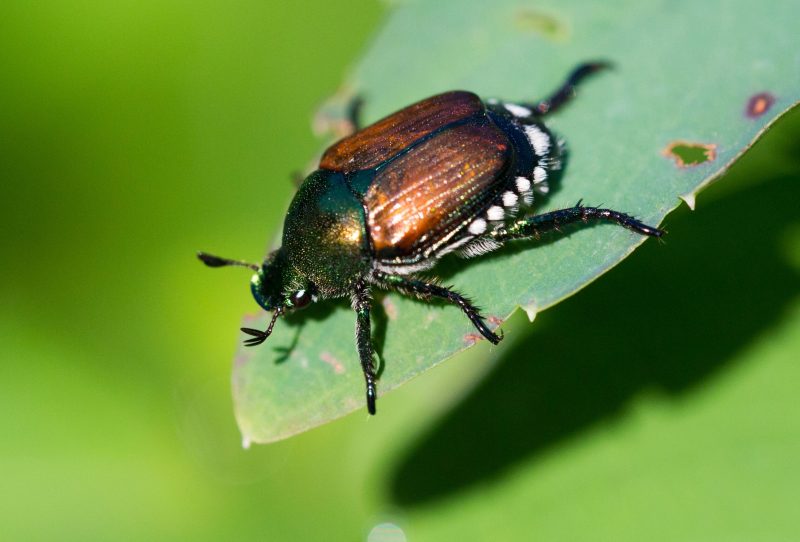
The Japanese beetle is a small, metallic insect known for its shiny green head and copper-colored wing covers. This bright, iridescent coloration makes it one of the easiest beetles to identify in New York during summer. Although not harmful to humans, it is a major agricultural and garden pest due to its destructive feeding habits.
Adult beetles measure about 8 to 11 millimeters in length and have a compact, oval-shaped body. A key identification feature is the row of white tufts along the sides of the abdomen. Their strong mandibles allow them to chew through leaves, flowers, and fruit with ease, often leaving behind skeletonized foliage.
Japanese beetles thrive in gardens, orchards, parks, and grassy areas. Their larvae, known as grubs, develop in soil and feed on grassroots, causing brown patches of turf. Adults emerge in large numbers, often forming clusters on plants and causing widespread damage during midsummer.
Although they do not sting or bite, their feeding habits make them ecologically harmful. They can weaken crops, damage ornamental plants, and stress trees when populations are high. For homeowners and farmers, their persistent activity and ability to spread quickly make them one of the most frustrating pests in the region.
Centipede (House Centipede)
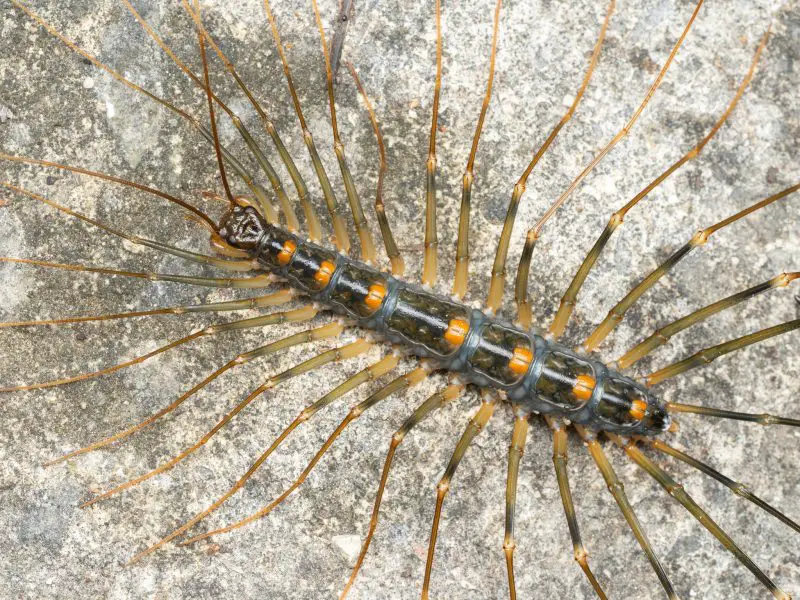
House centipedes are elongated, fast-moving arthropods with a distinct segmented body and long, delicate legs. Their bodies are typically yellowish-gray with dark striping down the back, giving them a slightly banded appearance. Their extremely long antennae and quick, darting movements often startle people when spotted indoors.
They typically measure 25 to 40 millimeters in length, though their long legs make them appear much larger. Each body segment has a pair of legs, and the last pair on adults can extend far behind the body. Their mouthparts are equipped with fangs that can deliver venom, but these fangs are small and rarely able to puncture human skin effectively.
House centipedes prefer damp, dark environments such as basements, bathrooms, crawl spaces, and under sinks. Outdoors, they hide beneath rocks, logs, and leaf litter. They are beneficial predators, feeding on spiders, roaches, silverfish, termites, and other household pests. Their presence indoors often indicates excess moisture.
While they can bite, such incidents are rare and usually result only in mild, sharp pain similar to a bee sting. Their venom is not harmful to humans beyond slight swelling or redness. The primary concern for most people is their sudden appearance and speed rather than any real danger, making them more unsettling than harmful.
Earwig
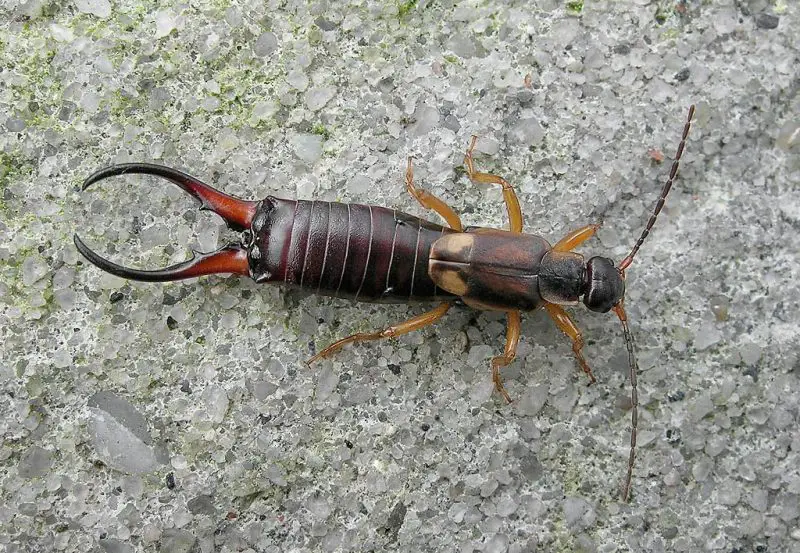
Earwigs are slender insects with elongated bodies, dark brown coloration, and distinctive forceps-like pincers at the end of the abdomen. Their appearance has long contributed to myths about them entering ears, though this behavior is not based in reality. They are harmless in most situations and are more of a nuisance than a threat.
Adults generally measure between 12 and 25 millimeters in length. Their pincers, or cerci, differ between males and females—male pincers are more curved and pronounced, while female pincers are straighter. Although they possess wings, most earwigs rarely fly and rely on crawling to move around.
Earwigs prefer moist, sheltered environments such as mulch beds, garden soil, under rocks, and in decaying vegetation. They often wander indoors during warm months seeking humidity or food sources. In New York, they are common in gardens and landscaping areas where moisture is plentiful.
While earwigs can pinch when handled or threatened, their forceps are not strong enough to break skin in most cases. They do not carry venom or transmit diseases, and their pinches leave only minor discomfort. Their low risk level and tendency to avoid confrontation place them among the least dangerous insects in New York.
FAQs About Dangerous Bugs in New York
Are there dangerous bugs in New York that can seriously harm humans?
Yes. New York is home to several insects and arachnids capable of causing medical issues. Species like black-legged ticks, yellowjackets, bald-faced hornets, lone star ticks, and fire ants can deliver venomous bites or stings that may lead to allergic reactions, infections, or disease transmission.
Which bug in New York is considered the most dangerous?
The black-legged tick is often considered the most dangerous due to its ability to transmit Lyme disease, anaplasmosis, and babesiosis. Its small size and painless bite make infections harder to detect early.
Are mosquitoes in New York capable of spreading viruses?
Yes. Culex mosquitoes can transmit West Nile virus, while Aedes and Asian tiger mosquitoes may spread viruses like Zika, dengue, and chikungunya, though widespread local transmission is uncommon.
Do hornets and wasps attack in groups?
Some do. Yellowjackets and bald-faced hornets are especially aggressive and may swarm if their nest feels threatened. Their stings are painful, and multiple stings can become dangerous.
Are velvet ants really harmful to humans?
Velvet ants are not aggressive, but their sting is extremely painful. They do not bite or attack unless handled, but stepping on one barefoot can result in a severe sting.
Can giant water bugs bite people?
Yes. Giant water bugs can deliver a very painful bite when picked up or mishandled. Although the bite is not venomous, it can cause intense pain and temporary numbness.
Are carpenter ants dangerous to humans?
Carpenter ants do not have venom and rarely bite, but their ability to excavate wood can damage homes. Large infestations may weaken structural components over time.
Are house centipedes dangerous?
House centipedes can bite, but this is rare and usually results in mild pain or localized redness. They are generally harmless and are considered beneficial because they prey on household pests.
Do blister beetles pose a medical risk?
Yes. Blister beetles can release cantharidin, a chemical that causes painful skin blisters on contact. While usually not dangerous, the irritation can be severe, and ingestion is toxic to pets and livestock.
Are earwigs harmful or dangerous?
No. Earwigs may pinch if threatened, but the pinch is mild and not medically significant. They do not spread disease and are considered low-risk pests.
Final Thoughts
New York hosts a wide variety of insects and arachnids, some harmless and others capable of causing real medical concerns. From ticks that spread serious diseases to wasps that defend their nests aggressively, understanding these species helps reduce risks during outdoor activities. Many of these pests thrive in warm seasons, dense vegetation, or areas with standing water, making awareness and prevention essential for residents, hikers, and gardeners alike.
While some insects cause only mild irritation, others can transmit illnesses, trigger allergic reactions, or inflict painful bites and stings. Staying informed allows you to recognize potential threats, take proper precautions, and avoid unnecessary encounters. By respecting their habitats and learning how to identify them, you can enjoy New York’s natural environments with greater confidence and safety.


